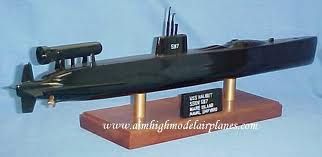The first Navy Nuke was the Regulus; Mach .9, 500 mile range, and that was first deployed on USS Los Angeles CA-135.
The first four Regulus submarines; USS Tunny SS/SSG-282 (a converted Gato), USS Barbero SS/SSG 317 (a converted Balao), USS Grayback SSG-574 and USS Growler SSG-577 (both new construction), were diesel electric.
Regulus II; Mach 2, 1,200 mile range needed a "bigger boat".
USS Halibut SSGN-587was built at Mare Island and commissioned in 1960.

SSBN-598 was commissioned in the same year, and spelled the end for Regulus.
Halibut then served in a series of DSRV tests, although details are sketchy. With their large hangars, these boats were used as AP's and LP's for all kinds of shady stuff.